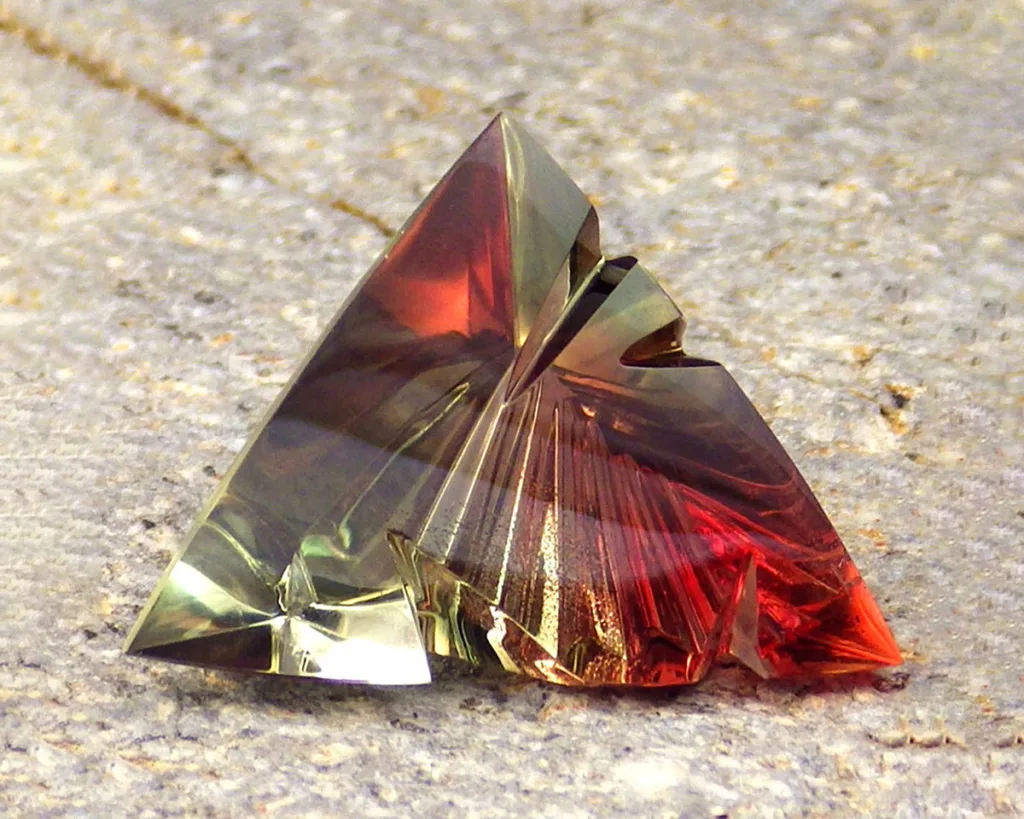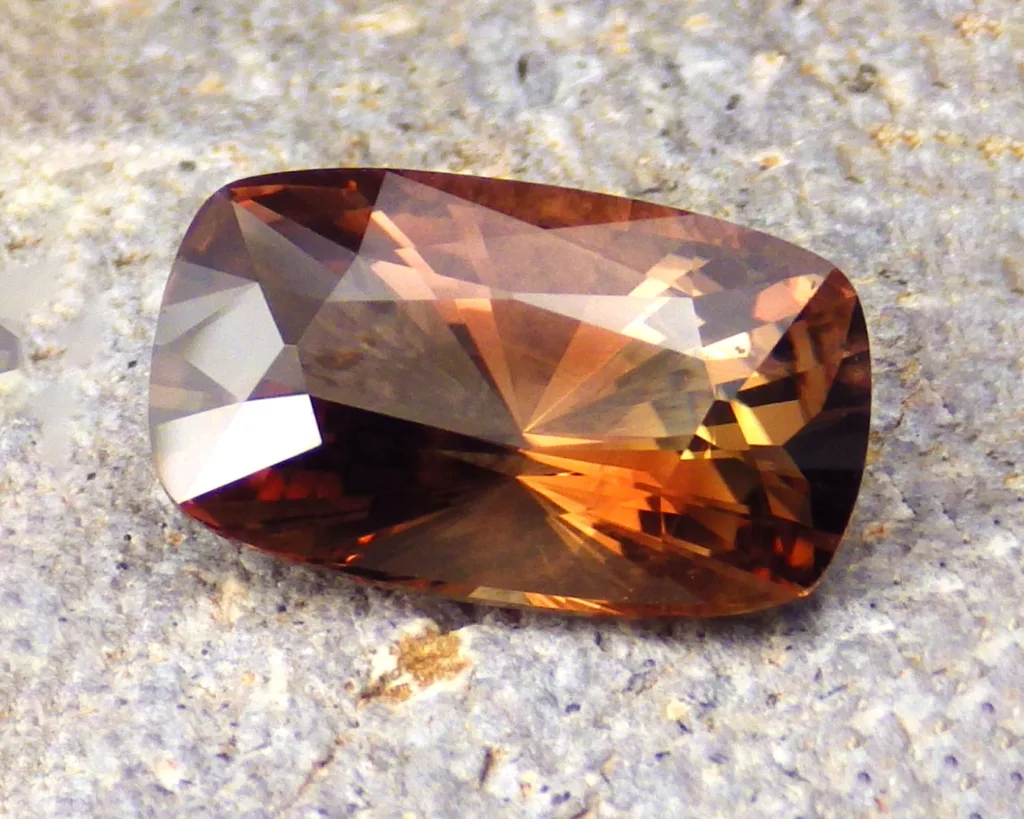Sunstone is a type of translucent, feldspar mineral that is often orange to reddish-brown and displays a shimmering or glittery effect, called aventurescence, when viewed under light. This visual effect is caused by inclusions of copper or other minerals that reflect light, creating a sparkling or glowing appearance. Sunstone is primarily composed of plagioclase or orthoclase feldspar, and its color can vary depending on the composition of the mineral.

It is commonly used as a gemstone in jewelry and has been found in various parts of the world, including the United States (particularly Oregon), India, Norway, and Canada. In metaphysical circles, sunstone is often associated with positive energy, vitality, and the power of the sun, making it popular for spiritual and healing purposes.
Discovery
The discovery and use of sunstone date back to ancient times. While it’s difficult to pinpoint an exact “discovery” moment, several cultures across history have utilized sunstone in various forms, particularly in jewelry and spiritual practices.
Historical Background:
- Vikings and Navigation: Some historians believe that Viking sailors may have used sunstone as a navigation tool. Legend suggests that a “solar stone” helped them locate the sun on cloudy or foggy days by polarizing sunlight, allowing them to determine the sun’s position even when it wasn’t visible. While the exact mineral referred to as “sunstone” in these Viking sagas is debated, some researchers propose that it could have been a calcite crystal or a form of feldspar like sunstone.
- Ancient Greece and Rome: Sunstone was prized in ancient Greece and Rome for its beauty. It was associated with the sun god, particularly Helios (in Greek mythology) and Sol (in Roman mythology), and was often used as an offering to these deities.
- Modern Discovery: In the 19th and 20th centuries, sunstone deposits were discovered and mined in various locations worldwide. Significant deposits of high-quality sunstone were found in Oregon, USA, in the early 20th century, leading to its popularity in modern jewelry making. Oregon sunstone, in particular, is known for its vivid color and aventurescence, and it became the state gemstone of Oregon in 1987.
Today, sunstone is both a scientifically studied mineral and a cherished gemstone with ancient and modern significance.
Properties

Sunstone possesses a unique combination of physical and optical properties that make it highly valued both as a gemstone and in mineralogy. Here are its key properties:
1. Physical Properties:
- Chemical Composition: Sunstone is a variety of feldspar, primarily composed of plagioclase (labradorite) or orthoclase. Its chemical formula is usually expressed as a sodium-calcium-aluminum silicate.
- Hardness: It has a hardness of 6 to 6.5 on the Mohs scale, making it fairly durable for everyday jewelry.
- Cleavage: Sunstone exhibits two directions of perfect cleavage, meaning it can break cleanly along these planes.
- Density: Its specific gravity (density) ranges between 2.56 and 2.76.
- Fracture: Sunstone has a conchoidal to uneven fracture, breaking with a smooth curved surface when not cleaving along natural planes.
2. Optical Properties:
- Aventurescence: The most distinctive feature of sunstone is its aventurescence, a glittering or shimmering effect caused by light reflecting off inclusions of copper, hematite, or other minerals. This gives sunstone its characteristic sparkle.
- Transparency: Sunstone ranges from transparent to translucent. High-quality sunstones are often more transparent with a stronger optical effect.
- Color: The color can vary from pale yellow, orange, and reddish-brown to green or blue (rare). The color comes from tiny inclusions of copper or other minerals.
- Luster: Sunstone typically exhibits a vitreous (glass-like) luster.
- Refractive Index: The refractive index of sunstone is between 1.52 and 1.57, which affects how it bends light and contributes to its brilliance.

3. Metaphysical Properties (according to spiritual and healing beliefs):
- Symbolism: Sunstone is often associated with leadership, personal power, and vitality. It is thought to bring optimism, joy, and warmth, much like the energy of the sun.
- Chakra Association: It is often linked to the solar plexus and sacral chakras, enhancing confidence and creativity.
- Emotional Healing: Sunstone is believed to combat stress, boost self-esteem, and stimulate enthusiasm.
4. Notable Varieties:
- Oregon Sunstone: Found in the United States, this variety is known for its copper inclusions and strong aventurescence.
- Indian Sunstone: Tends to have more muted colors but is still prized for its glittering effect.
- Norwegian Sunstone: Historically linked to Viking navigation, though the actual mineral used by Vikings is debated.
The combination of its visual appeal, durability, and historical significance makes sunstone a popular choice in both gem collections and spiritual practices.
Origins
Sunstone’s origins trace back to several geological processes and diverse geographical locations where it forms naturally. These origins are tied to specific regions and the mineral compositions that define the gemstone.

Geological Origins:
Sunstone is a plagioclase feldspar or orthoclase feldspar mineral that forms in igneous rocks like lava and basalt. The glittering aventurescence characteristic of sunstone is due to inclusions of metallic compounds, typically copper, that form as the mineral crystallizes.
The formation process typically occurs in volcanic environments or within intrusive igneous rock. Over time, as magma cools and solidifies, crystals of feldspar (which become sunstone) grow, trapping minute copper or hematite inclusions within the mineral structure. The size and density of these inclusions influence the intensity of the aventurescence.
Geographical Origins:
Sunstone has been discovered in various parts of the world, each with its unique characteristics based on the local geology. Here are some of the key locations where sunstone is found:
1. Oregon, USA:
- Oregon Sunstone is perhaps the most famous variety, known for its vivid colors ranging from transparent yellow to red, green, and even bi-colored stones. It often contains copper inclusions, which give it a strong aventurescent glow.
- Discovered in the early 20th century, Oregon sunstone is mined in the state’s Ponderosa and Rabbit Basin areas.
- It became Oregon’s official state gemstone in 1987 and is highly sought after for jewelry making.
2. India:
- India is one of the largest sources of commercial sunstone, producing stones that are generally more affordable. Indian sunstone tends to be less transparent and has a more subtle shimmer compared to Oregon sunstone.
- The stones from India are typically orange to reddish-brown and are used extensively in mass-market jewelry.
3. Norway:
- Norwegian sunstone, sometimes referred to in connection with Viking legend, has historical importance. While it’s unclear whether the Vikings used sunstone for navigation (or if it was a different mineral like calcite), feldspar deposits in Norway include sunstone-like materials.
- The stones found in this region have a more muted color but still exhibit some aventurescence.
4. Canada:
- Canada also has deposits of sunstone, primarily in the Yukon region. The stones here are similar to those found in Norway, with a range of orange, yellow, and reddish hues.
5. Tanzania:
- Sunstone has been found in Tanzania, often alongside other gems like garnet and sapphire. Tanzanian sunstone typically shows a range of colors and may have a slight shimmer, although it is less known than Oregon or Indian varieties.
6. Russia:
- In Russia, sunstone deposits are found, particularly in the Ural Mountains. Russian sunstone often displays deep orange and reddish hues and is appreciated for its aventurescent quality.
Cultural Origins:
Sunstone has historical and cultural significance in various parts of the world:
- Viking Legends: As mentioned earlier, Vikings are believed to have used a mineral called “solar stone” for navigation by polarizing light. While some debate remains whether this was sunstone or another crystal like Iceland spar (calcite), the lore of sunstone in Viking culture persists.
- Native American Cultures: In North America, some Native American tribes believed sunstone had spiritual and healing properties, symbolizing the sun’s power and bringing life, warmth, and abundance.




































